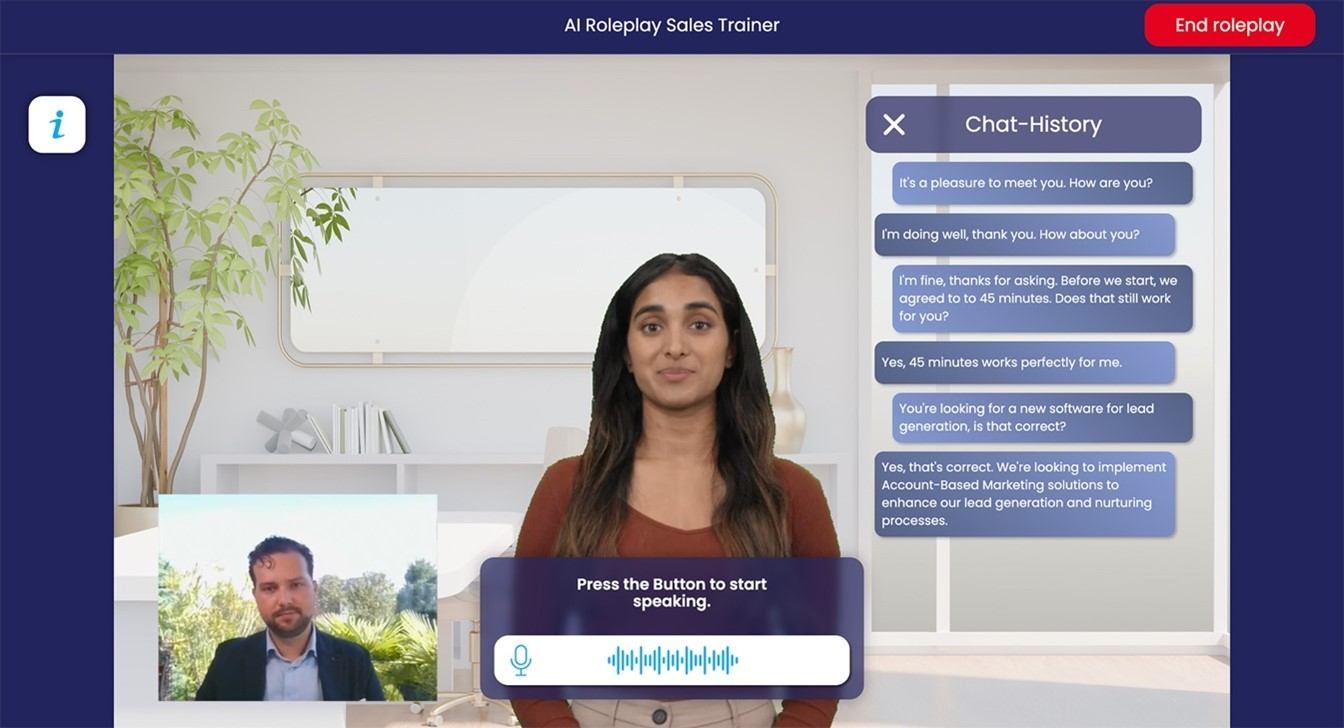
AI Role-Play In Learning And Development
In today’s rapidly evolving corporate environment, developing effective training methods is more important than ever. Learning and Development (L&D) departments are tasked with finding innovative ways to help people improve, stay engaged, and address the variety of challenges that come with a diverse workforce. As technology continues to play a bigger role in learning, new solutions are emerging to enhance training programs. AI role-play is one such solution, providing a fresh and innovative way to engage employees through immersive learning. The solution provides interactive and lifelike scenarios that make training more engaging and impactful than traditional methods.
This article will explore how organizations can use AI role-play to enhance their L&D initiatives, improving both employee performance and business outcomes.
How To Utilize AI Role-Play For Training
1. Creating Engaging And Realistic Training Scenarios
One of the main challenges in training is ensuring that employees are able to transfer their learning to real-world situations. Traditional classroom training often lacks the practical application needed for employees to effectively develop new skills. AI role-play addresses this issue by offering immersive, interactive simulations where users can practice handling real-life conversational scenarios.
Whether it’s a difficult customer interaction, a high-stakes negotiation, or a performance review with a direct report, AI role-play creates lifelike scenarios where employees can test different approaches in a safe environment. For example, sales teams can practice delivering pitches, HR managers can refine their interview techniques, and customer service agents can work through complaint-handling exercises.
With the integrated real-time AI avatars, the scenarios evolve based on the employee’s responses. This dynamic and adaptive environment ensures that learners aren’t simply memorizing steps, but instead developing critical thinking and problem-solving skills that will serve them in their everyday responsibilities.
2. Improving Soft Skills With Practical Application
Soft skills like communication, empathy, and conflict resolution are essential in the workplace, yet they can be challenging to teach. AI role-play allows employees to practice these skills in a risk-free environment where they receive customized and personal feedback to help improve their interpersonal skills. This approach, combined with AI-driven adaptive scenarios, ensures that employees can practice managing difficult conversations with realistic responses from AI avatars.
This kind of training goes deeper than just basic improvements. It helps build emotional intelligence and adaptive thinking, making employees better at handling challenging conversations in real-life situations.
3. Cost-Effective And Scalable Learning
One of the most significant advantages of AI role-play is its scalability. Traditional face-to-face role-playing sessions can be costly and time-consuming, especially when large groups need to be trained. AI role-play provides a more cost-effective solution, enabling organizations to deliver scenario-based training to employees across multiple locations or departments without the logistical challenges of face-to-face trainings.
4. Fostering A Culture Of Continuous Learning
Integrating AI role-play into L&D programs supports a culture of continuous learning. Employees can go through simulations multiple times, improving their skills and handling new challenges. This approach fits well with today’s workforce, which values ongoing professional growth.
AI role-play offers personalized learning experiences, ensuring that employees can progress at their own pace. Employees are no longer passive recipients of information but can actively participate in their own development. Being able to practice and get feedback right away helps create a continuous learning cycle. This not only makes employees more effective in their jobs but also boosts overall performance for the organization.
5. Enhancing Leadership And Management Training
AI role-play can also be used to develop leadership and management skills. Managers often face complex situations requiring careful communication, problem solving, and decision making. With AI role-play, leaders can simulate challenging conversations, such as delivering critical feedback, resolving team conflicts, or making important decisions.
By practicing these scenarios in a controlled environment, managers can experiment with different strategies, receive feedback, and learn from their mistakes without real-world consequences. This type of learning is essential for leadership development, as it helps managers build confidence in handling complex situations, leading to more effective leadership and better decision-making. Moreover, AI role-play can simulate difficult curveball situations, such as handling unexpected crises or managing conflicting priorities, which are common challenges managers face. By training managers in these scenarios, organizations can better prepare their leaders for real-world situations they will encounter.
6. Adapting To A Diverse Workforce And Varied Learning Styles
AI role-play effectively meets the needs of a diverse workforce. Employees come with different backgrounds, learning styles, and skill levels, so it’s important for L&D programs to accommodate these differences. AI role-play offers personalized learning experiences, allowing employees to engage with the material at their own pace and revisit simulations whenever necessary.
For example, some employees might need several tries to master a customer service scenario, while others may want to focus on improving their negotiation skills. This flexibility ensures that everyone can progress in a way that works for them. Plus, the customizable simulations allow organizations to create scenarios that are relevant to specific cultures or that address unique challenges within different teams or departments.
7. Ensuring Data-Driven L&D Outcomes
L&D teams can use AI role-play’s ability to generate useful data to enhance trainings programs. This helps create more personalized training paths and ensures that L&D strategies are both efficient and effective.
This data can also be used by L&D teams to measure how training impacts overall performance, giving organizations a clearer view of their Return On Investment (ROI). For example, they can track improvements in customer satisfaction or employee engagement after AI role-play training and use those findings to shape future learning initiatives.
How To Deploy AI Role-Play
AI role-play is designed for ease of deployment and flexibility. As a web-based solution, it can be accessed directly through any browser, eliminating the need for additional software installations. This ensures that employees can engage with the training content from any location, whether at their desks or on mobile devices.
For organizations using a Learning Management System (LMS), AI role-play is SCORM-compliant, making it easy to integrate into existing training programs. This allows for seamless tracking of learner progress and performance. However, AI role-play can also function effectively as a standalone tool, accessible through a browser, offering a straightforward solution for those not using an LMS.
Additionally, AI role-play can be integrated into web-based training programs or other formats, replacing traditional quizzes with dynamic, conversational scenarios. This approach provides a more engaging and interactive learning experience, allowing learners to apply their knowledge in practical, real-world simulations.


Parting Thoughts
AI role-play serves as a valuable tool for Learning and Development, addressing the key aspects necessary for effective training in today’s corporate landscape. By creating engaging and realistic scenarios, it allows employees to practice essential skills in a safe environment. The focus on conversational practice enables learners to improve their communication, empathy, and conflict resolution abilities, which are critical for success.
The solution’s scalability makes it a cost-effective training option, allowing organizations to reach employees across various locations while providing tailored experiences to suit different learning styles. This adaptability supports a culture of continuous learning, encouraging employees to refine their skills through repeated interactions with AI avatars.
Moreover, AI role-play enhances leadership training by simulating complex situations that require nuanced decision-making. As organizations track performance data from these simulations, they can ensure that L&D initiatives remain data-driven and effective.
AI role-play is designed for flexibility in deployment. As a web-based solution, it can be accessed easily through any browser, allowing employees to engage with training content from anywhere. This adaptability ensures seamless integration into existing systems and enhances the learning experience by replacing traditional quizzes with dynamic, conversational scenarios.
In summary, integrating AI role-play into training programs equips employees with the tools they need to thrive. By focusing on communication and interpersonal skills, organizations position themselves for long-term success in a dynamic business environment.
